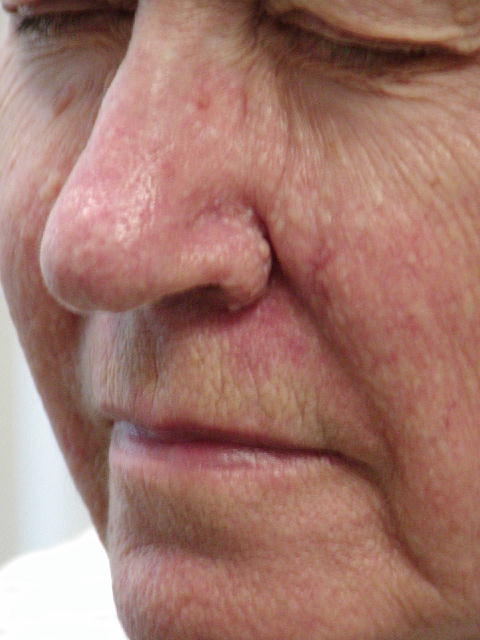CORRECT DIAGNOSIS:
Eosinophilic Granulomatosis with Polyangiitis (EGPA)
DISCUSSION:
Eosinophilic Granulomatosis with Polyangiitis (EGPA), formerly known as Churg-Strauss Syndrome is a systemic necrotizing vasculitis with granulomatous inflammation associated with asthma and peripheral eosinophilia. While the cause is still considered idiopathic, it has been associated with environmental factors such as infections, vaccinations, allergens, and medications, most notably leukotriene receptor antagonists.
It is classically considered a Th2-mediated process that is ANCA-positive in about 40% of cases. EGPA classically evolves through 3 stages. The first is the prodromal stage, characterized by months to years of symptoms such as asthma, arthralgias, myalgias, fever, malaise, and weight loss. Asthma is the key feature of the prodromal phase and is present in nearly 100% of patients with EGPA.
The second stage of the disease is the eosinophilic stage, characterized by marked peripheral eosinophilia that may damage the gastrointestinal tract, lungs, kidney, and heart. Lung parenchymal involvement is most common (2/3 of patients) and may lead to cough or hemoptysis. Pulmonary infiltrates may be seen on chest CT. GI system involvement may cause abdominal pain, diarrhea, and GI bleeding. Cardiac involvement may lead to endomyocardial infiltration and is a leading cause of death from EGPA. Renal involvement is most rare but can lead to glomerulonephritis.
The third (vasculitic) stage is characterized by constitutional symptoms and cutaneous findings such as palpable purpura, usually on the lower extremities. This may take the form of skin necrosis, subcutaneous nodules, red-brown papules/plaques, and variable ulceration. During this phase of the disease, neurologic symptoms may develop, including foot and wrist drop.
TREATMENT:
Initially – 20 mg prednisone taper which was effective at reducing the signs/symptoms of the disease. Azathioprine 50 mg PO QD then started after the prednisone taper and return of symptoms. Inadequate control of symptoms with azathioprine 50mg PO QD after 2 months led to increasing the dose to 50 mg PO BID.
Given concerns for long-term use of azathioprine, the patient has been successfully controlled on 10 mg of prednisone every other day.
REFERENCES:
Simon, H. U., Rothenberg, M. E., Bochner, B. S., Weller, P. F., Wardlaw, A. J., Wechsler, M. E., et al. (2010). Refining the definition of hypereosinophilic syndrome. Journal of Allergy and Clinical Immunology, 126(1), 45–49. https://doi.org/10.1016/j.jaci.2010.03.025
Grau, R. G. (2008). Churg-Strauss syndrome: 2005-2008 update. Current Rheumatology Reports, 10(5), 453–458. https://doi.org/10.1007/s11926-008-0076-2
Loughlin, J. E., Cole, J. A., Rothman, K. J., et al. (2002). Prevalence of serious eosinophilia and incidence of Churg-Strauss syndrome in a cohort of asthma patients. Annals of Allergy, Asthma & Immunology, 88(3), 319–325. https://doi.org/10.1016/S1081-1206(10)62076-0
Vaglio, A., Martorana, D., Maggiore, U., et al. (2007). HLA-DRB4 as a genetic risk factor for Churg-Strauss syndrome. Arthritis and Rheumatism, 56(9), 3159–3166. https://doi.org/10.1002/art.22894
Hauser, T., Mahr, A., Metzler, C., et al. (2008). The leucotriene receptor antagonist montelukast and the risk of Churg-Strauss syndrome: a case-crossover study. Thorax, 63(8), 677–682. https://doi.org/10.1136/thx.2007.088454
Moosig, F., Gross, W. L., Herrmann, K., Bremer, J. P., Hellmich, B. (2011). Targeting interleukin-5 in refractory and relapsing Churg–Strauss syndrome. Annals of Internal Medicine, 155(5), 341–343. https://doi.org/10.1056/NEJMoa1511619
Radice, A., Bianchi, L., Sinico, R. A. (2013). Anti-neutrophil cytoplasmic autoantibodies: methodological aspects and clinical significance in systemic vasculitis. Autoimmunity Reviews, 12(5), 487–495. https://doi.org/10.1016/j.autrev.2012.07.013
Vaglio, A., Strehl, J. D., Manger, B., Maritati, F., Alberici, F., Beyer, C., et al. (2012). IgG4 immune response in Churg–Strauss syndrome. Annals of the Rheumatic Diseases, 71(3), 390–393. https://doi.org/10.1136/ard.2011.150351
Lanham, J. G., Elkon, K. B., Pusey, C. D., Hughes, G. R. (1984). Systemic vasculitis with asthma and eosinophilia: a clinical approach to the Churg–Strauss syndrome. Medicine, 63(1), 65–81. https://doi.org/10.1097/00005792-198401000-00005
Keogh, K. A., Specks, U. (2006). Churg–Strauss syndrome. Seminars in Respiratory and Critical Care Medicine, 27(2), 148–157. https://doi.org/10.1055/s-2006-939829
Bolognia, J., Jorizzo, J., Schaffer, J. (2012). Dermatology (3rd ed., pp. 404-405). Philadelphia: Elsevier Saunders.
Masi, A. T., Hunder, G. G., Lie, J. T., et al. (1990). The American College of Rheumatology 1990 criteria for the classification of Churg-Strauss syndrome (allergic granulomatosis and angiitis). Arthritis & Rheumatism, 33(8), 1094–1100. https://doi.org/10.1002/art.1780330810
Pagnoux, C., Guilpain, P., Guillevin, L. (2007). Churg–Strauss syndrome. Current Opinion in Rheumatology, 19(1), 25–32. https://doi.org/10.1097/BOR.0b013e3280c441bb
Pepper, R. J., Fabre, M. A., Pavesio, C., Gaskin, G., Jones, R. B., Jayne, D., et al. (2008). Rituximab is effective in the treatment of refractory Churg–Strauss syndrome and is associated with diminished T-cell interleukin-5 production. Rheumatology, 47(8), 1104–1105. https://doi.org/10.1093/rheumatology/ken176
Moosig, F., Gross, W. L., Herrmann, K., Bremer, J. P., Hellmich, B. (2011). Targeting interleukin-5 in refractory and relapsing Churg–Strauss syndrome. Annals of Internal Medicine, 155(5), 341–343. https://doi.org/10.1056/NEJMoa1511619




